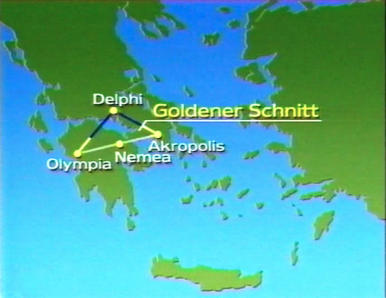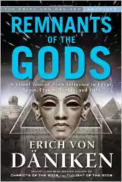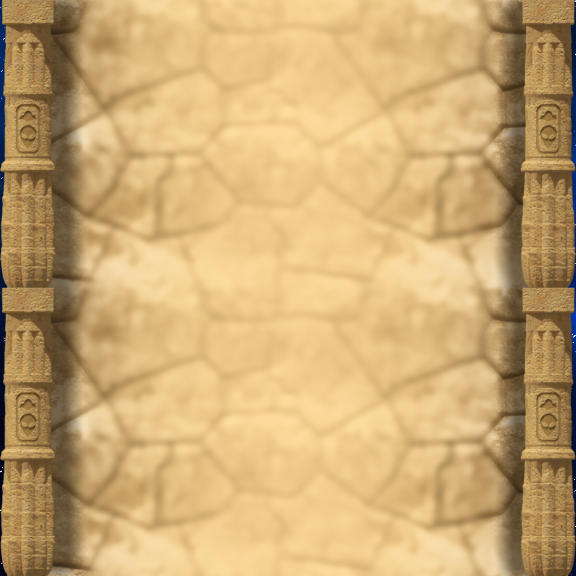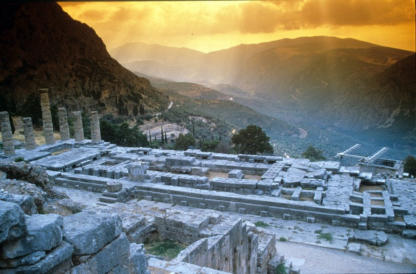





































Geoglyphs and worldwide geometrical
symbols
Greece lies under a geometrical grid!
Yet
there
is
method
in
this
madness.
What
is
the
probability
that
in
mountainous
terrain
three
temples
happen
to
lie
on
a
straight
line?
It
might
happen
in
two
or
three
cases.
In
Attica
and
Boeotia
(central
Greece)
alone
there
are
35
of
these
"three-temple
lines."
Tuscany salutes!
What
is
the
probability
that
the
linear
distances
between
holy
sites
is
the
same?
It
happens
22
times
in
central
Greece. Coincidence? Hardly.
And
Delphi,
the
"navel
of
the
world,"
plays
the
role
of
the
hub
airport
in
this
network.
Thus
Delphi
is
the
same
distance
from
the
Acropolis
and
Olympia.
We
can
construct
a
perfect
equilateral
triangle.
The
holy
site
of
Nemea
lies
at
the
half-way
point
of
the
cathetus
(one
of
the
two
shorter
legs
of
a
right-angled
triangle).
The
right-angled
triangles
of
Acropolis-
Delphi-Nemea
and
Nemea-Delphi-Olympia
have
the
same
hypotenuse,
and
its
ratio
to
the
common Delphi-Nemea line corresponds to the golden ratio.
And
now
things
get
even
more
peculiar:
the
distance
from
Delphi
to
Aphea
is
the
same
as
from
Aphea
to
Sparta.
The
distance
from
Delphi
to
Sparta
is
the
same
as
the
distance
from
Sparta
to
Thebes
and
–
incidentally
-
also
half
the
distance
of
the
line
from
Dodoni
to
Sparta
and
Dodoni
to
the
Acropolis.
The
distances
are
also
the
same
for
Delphi-Mycenae
and
Mycenae-Athens
or
Delphi-Gortys
(a
megalithic
ruin
on
Crete)
and
Delphi-Milet
in
Asia
Minor.
In
summary,
Delphi
is
geodetically
and
geometrically
related
to
Olympia,
Dodoni,
Eleusis,
Epidaurus,
Aphea,
the
Acropolis,
Sparta,
Mycenae,
Thebes,
Chalcis,
Nemea, Kinyra, Gortys, and Milet.
To
complete
this
madness,
we
still
need
to
swallow
the
following:
Everyone
can
imagine
an
equilateral
triangle.
But
in
ancient
Greece,
there
is
evidence
of
several
triangles
with
two
proportions
relating
to
the
different
leg
lengths.
It
works
as
follows.
Take
the
triangle
Dodoni-Delphi-Sparta:
the
places
have
the
same
leg
ratio
as
Dodoni-Sparta
to
Dodoni-
Delphi, Dodoni-Sparta to Sparta-Delphi, and Dodoni-Delphi to Delphi-Sparta.
The
triangle
Knossos-Delos-Chalcis:
the
places
have
the
same
leg
ratio
as
Knossos-
Chalcis
to
Knossos-Delos,
Knossos-Chalkis
to
Chalkis-Delos,
and
Knossos-
Delos
to
Delos-Chalkis.
The
triangle
Nieosia
(Cyprus)-Knossos
(Crete)-Dodoni:
the
places
have
the
same
leg
ratio
as Nicosia-Dodoni to Nicosia-Knossos, Nikosia-Dodoni to Dodoni-Knossos.
All
these
triangles
are
the
same.
With
the
assistance
of
the
military
geographie
office,
more
than
200
geometric
equivalent
ratios
were
nailed
down.
An
additional
148
proportions
based
on
the
golden
ratio
can
be
added
to
them.
To
keep
talking
about
coincidence
is
absurd.
After
all,
we
are
not
just
talking
about
names
on
a
map
but
cultic
sites
from
antiquity
-
or
to
be
precise,
prehistory.
Thus
the
temple
of
Apollo
in
classical
Delphi stands on foundations from the Stone Age.
Source:
Remnants
of
the
Gods, page 92














































Geoglyphs and
worldwide geometrical
symbols
Greece lies under a geometrical grid!
Yet
there
is
method
in
this
madness.
What
is
the
probability
that
in
mountainous
terrain
three
temples
happen
to
lie
on
a
straight
line?
It
might
happen
in
two
or
three
cases.
In
Attica
and
Boeotia
(central
Greece)
alone
there
are
35
of
these
"three-
temple lines." Tuscany salutes!
What
is
the
probability
that
the
linear
distances
between
holy
sites
is
the
same?
It
happens
22
times in central Greece. Coincidence? Hardly.
And
Delphi,
the
"navel
of
the
world,"
plays
the
role
of
the
hub
airport
in
this
network.
Thus
Delphi
is
the
same
distance
from
the
Acropolis
and
Olympia.
We
can
construct
a
perfect
equilateral
triangle.
The
holy
site
of
Nemea
lies
at
the
half-way
point
of
the
cathetus
(one
of
the
two
shorter
legs
of
a
right-
angled
triangle).
The
right-angled
triangles
of
Acropolis-Delphi-Nemea
and
Nemea-Delphi-
Olympia
have
the
same
hypotenuse,
and
its
ratio
to
the
common
Delphi-Nemea
line
corresponds
to
the
golden ratio.
And
now
things
get
even
more
peculiar:
the
distance
from
Delphi
to
Aphea
is
the
same
as
from
Aphea
to
Sparta.
The
distance
from
Delphi
to
Sparta
is
the
same
as
the
distance
from
Sparta
to
Thebes
and
–
incidentally
-
also
half
the
distance
of
the
line
from
Dodoni
to
Sparta
and
Dodoni
to
the
Acropolis.
The
distances
are
also
the
same
for
Delphi-Mycenae
and
Mycenae-Athens
or
Delphi-
Gortys
(a
megalithic
ruin
on
Crete)
and
Delphi-Milet
in
Asia
Minor.
In
summary,
Delphi
is
geodetically
and
geometrically
related
to
Olympia,
Dodoni,
Eleusis,
Epidaurus,
Aphea,
the
Acropolis,
Sparta,
Mycenae,
Thebes,
Chalcis,
Nemea,
Kinyra,
Gortys,
and Milet.
To
complete
this
madness,
we
still
need
to
swallow
the
following:
Everyone
can
imagine
an
equilateral
triangle.
But
in
ancient
Greece,
there
is
evidence
of
several
triangles
with
two
proportions
relating
to
the
different
leg
lengths.
It
works
as
follows.
Take
the
triangle
Dodoni-Delphi-Sparta:
the
places
have
the
same
leg
ratio
as
Dodoni-Sparta
to
Dodoni-Delphi,
Dodoni-Sparta
to
Sparta-Delphi,
and
Dodoni-Delphi
to Delphi-Sparta.
The
triangle
Knossos-Delos-Chalcis:
the
places
have
the
same
leg
ratio
as
Knossos-Chalcis
to
Knossos-Delos,
Knossos-Chalkis
to
Chalkis-Delos,
and Knossos- Delos to Delos-Chalkis.
The
triangle
Nieosia
(Cyprus)-Knossos
(Crete)-
Dodoni:
the
places
have
the
same
leg
ratio
as
Nicosia-Dodoni
to
Nicosia-Knossos,
Nikosia-
Dodoni to Dodoni-Knossos.
All
these
triangles
are
the
same.
With
the
assistance
of
the
military
geographie
office,
more
than
200
geometric
equivalent
ratios
were
nailed
down.
An
additional
148
proportions
based
on
the
golden
ratio
can
be
added
to
them.
To
keep
talking
about
coincidence
is
absurd.
After
all,
we
are
not
just
talking
about
names
on
a
map
but
cultic
sites
from
antiquity
-
or
to
be
precise,
prehistory.
Thus
the
temple
of
Apollo
in
classical
Delphi
stands
on
foundations from the Stone Age.
Source:
Remnants
of
the
Gods,
page 92








